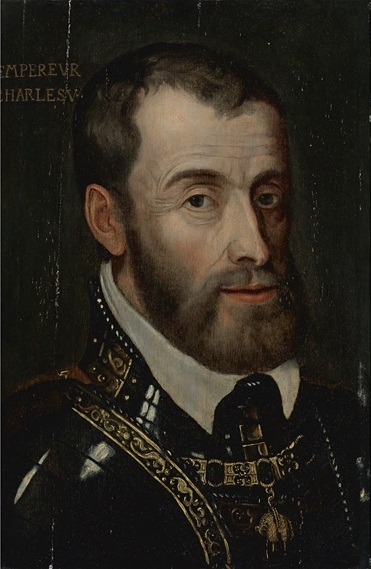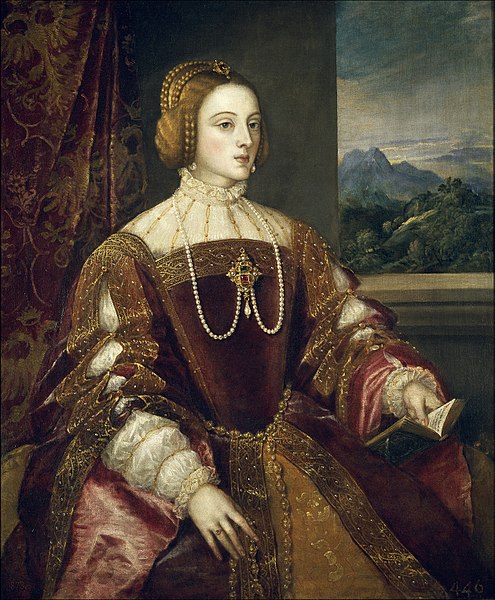- Joined
- Aug 13, 2004
- Messages
- 27,078
- City
- São Paulo
- Country
- Brazil
Carlos I (or V), Holy Roman Emperor, King of Aragon, Castile, Leon, Sicily and Napels, Archduke of Austria, Duke of Burgundy, Duke of Brabant, Luxembourg, Milan, Guelders, Lord of the Netherlands, Margrave of Namur, Count of Holland, Zeeland, Hainault, Zutphen, Artois, Flanders and Charlolais (Ghent, 24 February 1500 -Madrid, 21 September 1558); married by proxy in Almeirim on 1 November 1525 and in person in Seville on 10 March 1526, Princess Isabel of Portugal (Lisbon, 23 October 1503 - Toledo, 1 May 1539)
Reign Castile: 1516 - 1556
Reign Aragon: 1516 - 1556
Reign Holy Roman Empire: 1519 - 1556
Reign Burgundy: 1506 - 1556
Dynasty: Habsburg
Predecessor Castile: Queen Juana 'The Mad' of Castille
Predecessor Aragon: King Fernando VI of Aragon & Sicily
Predecessor Holy Roman Empire: Maximilian I, Holy Roman Emperor
Predecessor Burgundy: Duke Philip 'The Handsome of Burgundy
Succeeded in Spain by: King Felipe II of Spain
Succeeded in the Holy Roman Empire by: Ferdinand I, Holy Roman Emperor
Children: King Felipe II of Spain; Maria, Holy Roman Empress and Princess Juana of Spain
Parents Carlos: Duke Philip of Burgundy, Archduke of Austria and Queen Juana 'the Mad' of Castile
Parents Isabel: King Manuel I of Portugal and Princess Maria of Castile and Aragon
Siblings Carlos: Queen Leonor of Portugal; Queen Elizabeth of Denmark; Ferdidnand I, Holy Roman Emperor; Queen Maria of Hungary and Bohemia and Queen Catarina of Portugal
Siblings Isabel: King João III of Portugal; Duchess Beatrice of Savoy, Prince Luis, Duke of Beja; Prince Fernando Duke of Trancoso; Prince Alfonso, Princess Maria, King Henrique I, Prince Duarte, Duke of Guimaraes; and Prince Antonio of Portugal
Half Siblings Isabel: Prince Miguel da Paz; Prince Carlos and Princess Maria of Portugal
Reign Castile: 1516 - 1556
Reign Aragon: 1516 - 1556
Reign Holy Roman Empire: 1519 - 1556
Reign Burgundy: 1506 - 1556
Dynasty: Habsburg
Predecessor Castile: Queen Juana 'The Mad' of Castille
Predecessor Aragon: King Fernando VI of Aragon & Sicily
Predecessor Holy Roman Empire: Maximilian I, Holy Roman Emperor
Predecessor Burgundy: Duke Philip 'The Handsome of Burgundy
Succeeded in Spain by: King Felipe II of Spain
Succeeded in the Holy Roman Empire by: Ferdinand I, Holy Roman Emperor
Children: King Felipe II of Spain; Maria, Holy Roman Empress and Princess Juana of Spain
Parents Carlos: Duke Philip of Burgundy, Archduke of Austria and Queen Juana 'the Mad' of Castile
Parents Isabel: King Manuel I of Portugal and Princess Maria of Castile and Aragon
Siblings Carlos: Queen Leonor of Portugal; Queen Elizabeth of Denmark; Ferdidnand I, Holy Roman Emperor; Queen Maria of Hungary and Bohemia and Queen Catarina of Portugal
Siblings Isabel: King João III of Portugal; Duchess Beatrice of Savoy, Prince Luis, Duke of Beja; Prince Fernando Duke of Trancoso; Prince Alfonso, Princess Maria, King Henrique I, Prince Duarte, Duke of Guimaraes; and Prince Antonio of Portugal
Half Siblings Isabel: Prince Miguel da Paz; Prince Carlos and Princess Maria of Portugal
Last edited:




